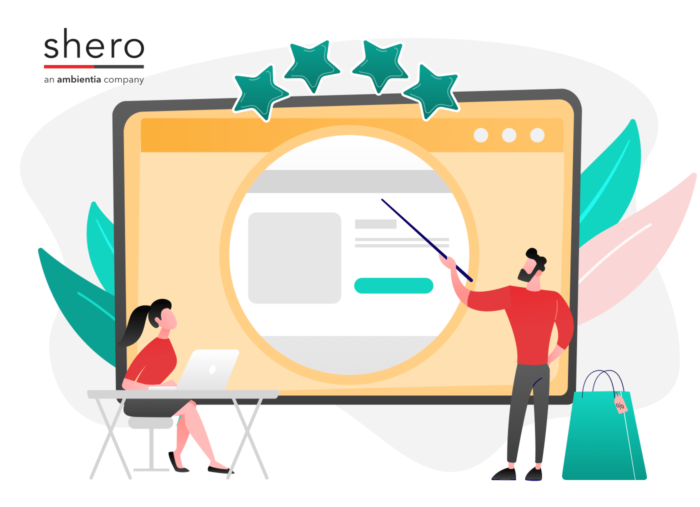The eCommerce holiday shopping season is around the corner, and that means every online business should be looking for sales cycle optimization methods to make their adjustments.
While there isn’t time for a complete site redesign or to figure out new products, there is still plenty of work to do to keep customers happy.
Let’s look at a few things to solidify before the holidays begin and some final improvements that can get your sales where you want them.
Please Note: This is a guest post contributed exclusively to the Shero Commerce blog by Jake Rheude, Vice President of Marketing for Red Stag Fulfillment.

What is eCommerce sales cycle optimization?
Sales cycle optimization is the work you do on your sales process to move people faster to “yes” while minimizing wasted effort and lost opportunities. Definitions and steps vary when talking about the sales cycle in general.
So, in this piece, we’ll think about it generally, including the following elements:
- Awareness
- Prospecting
- Initial contact
- Consideration
- Qualifying the lead
- Product presentation for demonstrating the value
- Decision
- Closing the deal
- Ensuring the sale and delivery
- Loyalty
- Follow-up for recurring revenue
For our take on sales cycle optimization, we want to think about how to move the right people through these steps faster or more efficiently. Sometimes, that’s cleaning up target lists. In other cases, it’ll be about removing barriers or adapting for more relevant messaging.
You first want to ensure that your eCommerce holiday strategy is still targeting the right people for your business.
1. Review personas and channels
Discussions around sales cycle optimization first often try to revamp landing pages or tighten up email campaigns in the B2B space. Those should definitely be part of your plan.
However, we want to start with the beginning of the sales cycle, and that means the people who could potentially fall into your funnel.
Kick things off with a revamp of your existing personas. Look at your organic and referral traffic, habits on your website, average order sizes, common locations, and other information. See if that information is still accurate to your existing targets or if something about them has changed.
It’s great if the problems you solve haven’t changed; that’s when you get to focus on just optimizing for the channels they use.
However, if your audience is different or you’re solving new problems, you’ll want to run through the main persona questions again:
- What are my customer demographics?
- What’s the issue I solve or the benefit that I provide?
- How do my customers usually tackle this problem or concern?
- How does my solution better fit their motivation?
- What’s the biggest obstacle to them choosing me?
That last question is always an intelligent method for sales cycle optimization, especially around the holidays.
You may need to adjust messaging, look in new areas, or tackle new threats (like more competitive pricing) because of what people expect during the holidays. Similar eCommerce shops are doing the same, so take time to refine your pitch based on year-end eCommerce holiday habits.
2. Refresh your site and load times
Now, to get a little more practical about sales cycle optimization. Part of securing more sales wins comes from optimizing leads and keeping them in the funnel. In today’s eCommerce world, that means every site refresh should include a look at loading times and functionality.
Start with your load time. Ideally, you want to load in 5 seconds or less because after that, each second of delay can create up to a 7% loss of conversions. On the other hand, decreasing load times generally bumps conversion rates up by at least 3%. Part of those wins come from reducing your bounce rate and improving the user experience.
The mobile share of eCommerce has been playing a larger role in sales in recent years, and it’s projected to surpass 430 billion U.S. dollars. Other data from Statista also shows that consumers are using mobile devices for more research. That includes their exposure to your ads and social campaigns. And as payment systems like Apple Pay continue to grow in their usage across both physical and digital spaces, the tools that support these will play a central role in more commerce.
Statista data paints an interesting mobile-commerce picture
Review your site specifically for the new personas and ensure nothing has broken during the past couple of years of development. Fight hard for the best mobile experience. Improving those elements will help you create a more enjoyable UX for all your visitors, especially if you keep load times in mind.
3. Update product pages for eCommerce holiday targets and deals
Your products’ core user base may not change during the holidays. However, what often changes is the reason for the purchase.
Gift shopping may mean your core buyers are getting your products for friends and family. Or, someone is looking at your website to buy for someone else who is your target demo.
Consider updating or creating new product pages and landing pages specific to your eCommerce holiday targets and related extensions. Give people a chance to find your products for those friend and family member targets. You might have product groups as gifts for dads or moms. Then, take it a step further and create pages for parents who love the outdoors or other aspects of your business.
Take your persona information and turn that into information accessible to holiday shoppers. Mix sales and education elements on these landing pages. That can be especially useful for gift shopping, where the audience may not understand why your options are better than others.
This is also the perfect time to highlight the shipping reliability you’ve had during the past few years. We’ve all seen how wild of a ride that can be, and we’ll get more into the behind-the-scenes aspect below. But, for 2022, promote buying early and shipping fast to ensure something arrives in time to delight.
4. Streamline checkout and automate updates
Closing the deal in eCommerce is as much about convincing someone to buy as it is not giving them a reason to head for the hills. Don’t neglect simplifying steps to make the experience easier and more enjoyable.
Begin this process by running through the standard checkout steps. People:
- Add things to carts
- click a “checkout” or “buy” button
- provide billing and shipping info
- choose a shipping method
- review the order
- confirm payment
Tighten up the end of your eCommerce sales cycle by speeding up these processes.
You want a mix of options and automation to help encourage the purchase. For example, allow people to create and log in to accounts so you can automatically enter billing or shipping details for them to verify. At the same time, offer guest checkouts so new shoppers can move quickly through the process.
Automation can also be simple. Allow people to check a box so that shipping and billing details are the same, reducing their input time. Social sign-ins can speed up your information capture.
And if you’re using social selling, like shoppable ads on Facebook, the sign-in also helps you track repeat buyers more easily.
Review the data you capture and ask if you actually need it and use it. If your sales and service teams don’t call customers first, take phone number fields off your forms. Clear away the clutter here. That’ll also help you get in the right mindset to clear out other distractions, buttons, and details that aren’t relevant to the checkout process.
Don’t give people a reason to get frustrated or a button to navigate them away from your sale page. In the same light, don’t hide things from people. List shipping pricing and taxes as soon as you can — even if it’s just an estimate. The later you save charges, taxes, and fees in this process, you are more likely to disrupt your sales cycle. Be clear about your pricing as early on as possible.
5. Get your shipping in order ASAP
The sales cycle is full of promises, and optimizing it requires you to ensure your promises are reliable. If you were able to maintain on-time, accurate deliveries during the past few years, highlight that across all your pages and interactions.
If you struggled, it’s time to get your house in order. This means renegotiating with major carriers or adding reliable regional carrier partners into the mix. Review the lead times you needed and how long your average shipping delays were. Bake that into the estimates you give customers even as you work to reduce it on the backend.
Check warehouse processes or partners to see if you can be more reliable by moving your same-day shipping and processing goals. Adjusting from 5 p.m. to 3 p.m., for example, may give your fulfillment team the flexibility they need to ship orders out on time during the eCommerce holiday rush.
Think about offering customers more shipping options, including expedited services. You want to tackle both fast and free shipping that different customers will want.
On the customer-facing side of this, start your promos early. People know to expect delays like we saw in the past few years.
Instead of just waiting and hoping, move up sales and coupons and other marketing elements. Try and secure more buyers sooner during the holiday season. That’ll help you to secure revenue faster and mitigate the risk that delays can cause.
Customers can and will cancel orders until your products arrive. The better you’re able to meet the expectations you set, the better your sales cycle optimization will be.
6. Thank customers and thank them again
While fulfillment is often the last timeframe for customers to cancel an order, it doesn’t end the sales process or your sales cycle optimization work.
The final stages in your cycle are about ensuring the good impression lasts so that someone wants to buy from you again. Make them happy, then keep them happy.
One of the best habits for this stage is to thank your shoppers repeatedly. After an eCommerce purchase happens, direct shoppers to a “thank you” page that explains the order is being processed and the next steps. When you provide updates like tracking information, say “thanks” again in those emails, your follow-up should mirror this language when you ask for a review or provide a deal to encourage an additional sale.
Maintain a positive relationship and work to solve problems. Being helpful also can be a great way to be thankful.
We also like ending with this mindset because these thank you notes are a great place to A/B test messaging during the eCommerce holiday season, which runs all of Q4. You don’t want to experiment a lot when sales are on the line. So, many turn off tests when they’re drilling down into sales cycle optimization. That’s because testing makes people nervous about losing the sale.
If that’s you, then focus on these after-sale items to see how people respond. Get their impressions or monitor clicks without making someone jump through an additional hoop for that first sale. You might find something that helps you reduce returns after the eCommerce holiday season or encourages multiple purchases as the year ends. Test and let the metrics guide you, just like the rest of your sales cycle optimization efforts.
With a positive attitude that keeps the customer first, you’re putting your business in a strong position to scale and have a very good New Year.
Ready to build out your digital strategy and optimize your online store to increase conversions through the holidays and into the new year? Contact us today.
About the author:
Jake Rheude is the Vice President of Marketing for Red Stag Fulfillment, an eCommerce fulfillment warehouse that was born out of eCommerce. He has years of experience in eCommerce and business development. In his free time, Jake enjoys reading about business and sharing his own experience with others.




